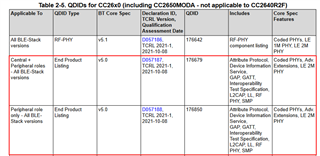Other Parts Discussed in Thread: CC2640, CC2650
I have multiple options that I am evaluating for this, and I am breaking them down into multiple posts. These posts may appear similar at first, but they have separate questions after the lead-in information is presented.
I am taking on the task of updating an existing product where we may need to replace the existing Bluetooth module (which is based on the CC2640F128). This project is only using BLE, and we are not adding any features even if we move to a chip/module that supports more features.
One goal of this update is to keep the redesign effort to a minimum. If we change to a different module, that will require a PCB redesign for the new footprint. If we change to a different BT chip, that will require porting or rewriting the code that runs on the BT module.
One thing that's not 100% clear is what we absolutely need to update to qualify for the BT SIG certification.
We have just tested the CC2650MODA in our current product by removing the BT module and air wiring the CC2650MODA. Our system was able to flash the binary built for the CC2640F128 onto the CC2650MODA module. This seems to work fine from a technical perspective, but that binary was built 7+ years ago. If we want to certify with the BT SIG, what (if anything) will we need to update to qualify the product with no testing required?



